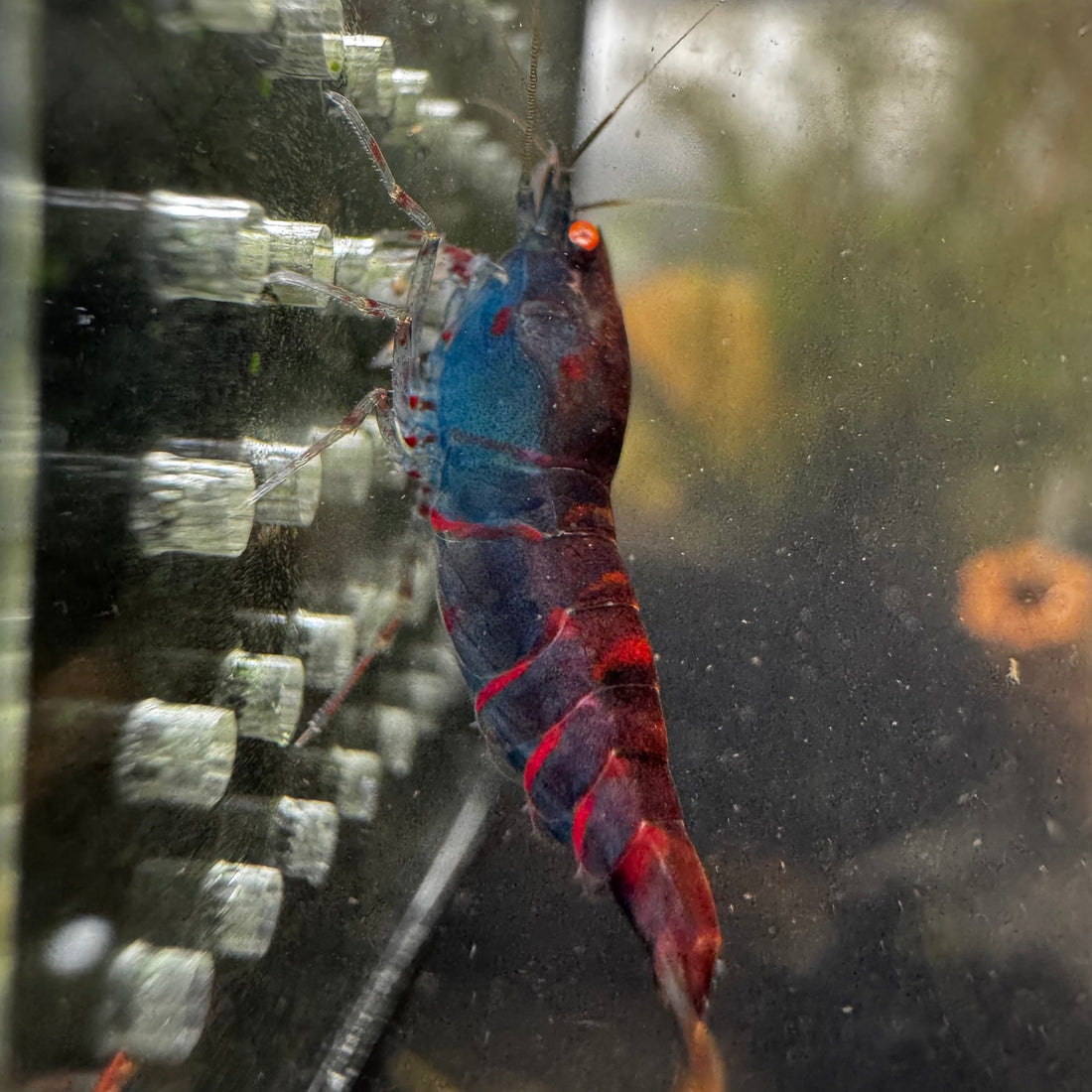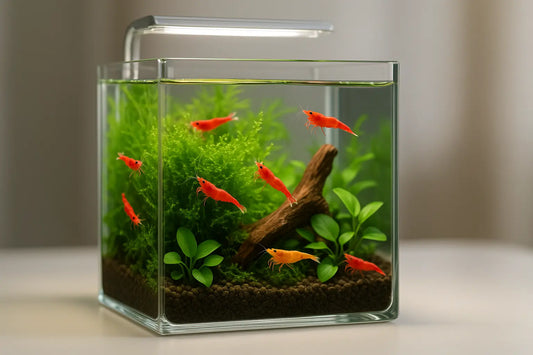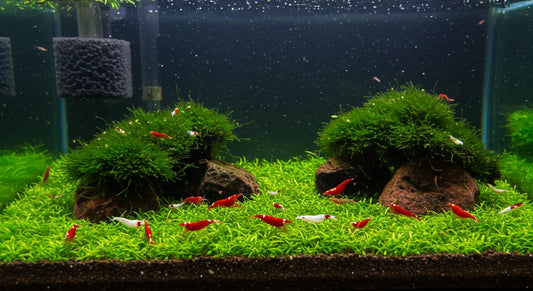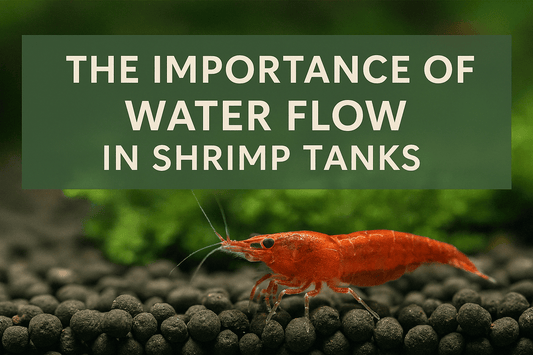
Best Practices for Setting Up a Shrimp Aquarium
Setting up a shrimp aquarium is not just about adding a few aquatic creatures to a tank—it’s about creating a thriving ecosystem. Shrimp, particularly freshwater species like Neocaridina davidi (commonly known as cherry shrimp), are perfect for beginners due to their vibrant colors, small size, and low-maintenance requirements. Beyond aesthetics, they play a critical role in tank cleaning by feeding on algae and leftover food.
Example: Imagine a 10-gallon tank adorned with lush green plants and vibrant red cherry shrimp gracefully scavenging for food—it’s not only beautiful but also incredibly rewarding to maintain.
Why start with shrimp?
- They’re easy to care for once you understand their needs.
- Shrimp aquariums are small and affordable to set up.
- Perfect for offices, small apartments, or beginner hobbyists.
Ready to create your first shrimp tank? Let’s dive into the essential steps!
Selecting the Right Equipment
The right equipment is the backbone of a successful shrimp aquarium. From choosing the tank size to selecting a filtration system, every decision impacts your shrimp’s health and happiness.
Aquarium Size and Type
- Beginners should start with a tank no smaller than 5 gallons. Larger tanks (10+ gallons) are better for maintaining stable water conditions.
- Opt for a rectangular tank as it allows more surface area for oxygen exchange, which is essential for shrimp health.
Filtration Systems
- Use sponge filters, which are shrimp-safe and provide gentle water movement. These filters also promote beneficial bacterial growth, crucial for water quality.
- Avoid strong filters that may suck up shrimp or disturb their natural environment.
Heating and Lighting
- Maintain water temperatures between 68°F–76°F using a reliable aquarium heater. If your home is in that range and doesn’t have huge temperature fluctuations, you can get away with not having a heater.
- Full spectrum LED lights not only illuminate your tank but also encourage plant growth, creating an optimal habitat for shrimp.
Brands like Fluval and AquaClear are highly recommended by seasoned aquarists for durability and shrimp safety, but new cheaper brands like Hygger are starting to make comparable products
Preparing the Aquarium
Now that you’ve chosen your equipment, it’s time to prepare the aquarium for its new inhabitants.
Substrate Selection
- Dark-colored substrates like black sand or gravel substrate enhance shrimp colors and promote natural behavior. For Green Jades and other darker shrimp, a lighter substrate helps you see their individual colors.
- Caridina will need a buffering substrate to help keep the PH low. We currently use Brightwell substrate in all our Caridina tanks.
- Avoid sharp gravel that could harm delicate shrimp.
Aquascaping
- Add live plants such as Java Moss or Bucephalandra. These provide hiding spots, reduce shrimp stress, and improve water quality by absorbing nitrates.
- Include driftwood and shrimp-safe rocks to create an aesthetically pleasing and functional environment.
Example Setup:
- Substrate: Black sand
- Plants: Java Fern, Cryptocoryne, and Amazon Sword
- Hardscape: Malaysian driftwood and lava rocks for climbing and hiding.
With your tank beautifully arranged, it’s time to cycle the water and create an environment shrimp will thrive in.
Understanding the Nitrogen Cycle
Before introducing shrimp to your tank, understanding the nitrogen cycle is essential. This process ensures your aquarium has a stable and safe environment for your shrimp by breaking down toxic waste products.
What is the Nitrogen Cycle? The nitrogen cycle converts harmful ammonia (produced from shrimp waste and decaying food) into nitrite and then into nitrate, which is less toxic. Beneficial bacteria in your filter and substrate drive this process.
Steps to Cycle Your Tank:
- Set Up the Tank: Add your substrate, plants, and decorations.
- Add a Source of Ammonia: Introduce fish food or a liquid ammonia source to feed the beneficial bacteria.
- Test the Water Regularly: Use an aquarium water testing kit to monitor ammonia, nitrite, and nitrate levels.
- Wait for Stability: Cycling can take 4-6 weeks. The tank is ready when ammonia and nitrite levels drop to zero, and nitrates remain low (below 20 ppm).
Avoid rushing this process! Many beginners lose shrimp due to uncycled tanks. Products like Seachem Stability can speed up the cycling process by adding beneficial bacteria. One way to speed up the process is to use a filter from a well seasoned tank. That is where most of the beneficial bacteria live so bringing an old sponge can greatly speed up the process.
Water Parameters and Maintenance
Maintaining ideal water parameters is vital for shrimp health. Shrimp are sensitive to sudden changes, so consistency is key.
Optimal Water Conditions for Neocaridina
- Temperature: 68°F–76°F (use a reliable thermometer).
- pH:5–7.5 for most neocaridina shrimp.
- Hardness (GH and KH): GH 4-10 and KH 0-4Soft to moderately hard water works best.
- TDS (Total Dissolved Solids): Aim for 150–250 ppm, depending on the shrimp species.
Weekly Maintenance Checklist:
- Water Changes: Replace 10–20% of the water every other week using dechlorinated water at the same temperature as the tank.
- Test Parameters: Regularly check pH, ammonia, nitrite, and nitrate levels.
- Clean Equipment: Gently rinse the filter sponge in tank water to preserve beneficial bacteria every other month or when it starts to get clogged.
Tools like API Freshwater Master Test Kit make monitoring water quality easy, even for beginners.
Selecting and Introducing Shrimp
Choosing the right shrimp species and introducing them properly can make all the difference for a successful tank.
Choosing Shrimp Species
- Beginner-Friendly Options: Cherry shrimp (Neocaridina davidi) are hardy and come in vibrant colors like red, yellow, and blue.
- Other Popular Choices: Crystal Red shrimp (Caridina cantonensis) and Amano shrimp (Caridina multidentata), though they may require more specific care.
Acclimation Process Shrimp are sensitive to changes in water chemistry, so acclimation is crucial:
- Keep the bag in a dark container in the same room as your shrimp for an hour or two to equalize temperatures.
- Use the drip method to slowly introduce tank water into the bag over 1-2 hours.
- Release the shrimp gently into the tank without adding the bag water.
Example: A beginner-friendly setup might include 10 cherry shrimp in a 10-gallon tank with live plants, sponge filters, and weekly maintenance.
Now that your shrimp are happily introduced, let’s talk about keeping them fed and healthy!
Feeding and Nutrition
Shrimp have simple dietary needs, but proper feeding is essential for their health and the overall balance of the aquarium ecosystem.
What Do Shrimp Eat? Shrimp are omnivores, feeding on biofilm, algae, and leftover food. Supplement their diet with quality shrimp pellets or wafers specifically formulated for freshwater shrimp.
Feeding Schedule and Tips
- Feed small amounts once a day, ensuring no leftover food after 2-3 hours.
- Provide a variety of food, such as:
- Shrimp-specific pellets (e.g., Hikari Shrimp Cuisine)
- Blanched vegetables like zucchini and spinach
- Protein-based foods like freeze-dried bloodworms (occasionally).
- Introduce Indian almond leaves or alder cones for added biofilm growth and natural dietary supplements.
Overfeeding is one of the most common beginner mistakes. Excess food decays and pollutes the water, harming shrimp. Stick to small portions!
Tank Mates and Compatibility
Choosing compatible tank mates ensures a peaceful environment where shrimp can thrive without stress or predation.
Shrimp-Friendly Tank Mates
- Peaceful nano fish like Ember Tetras, Strawberry Rasboras, and Otocinclus Catfish.
- Other bottom dwellers such as Nerite Snails or Malaysian Trumpet Snails.
- Avoid species that are known to prey on shrimp, like most cichlids or bettas, if it fits in a fish’s mouth, the fish will try to eat it.
Tips for Introducing Tank Mates
- Add shrimp to the tank first, allowing them to establish territory.
- Introduce fish or snails gradually to monitor interactions.
- Provide plenty of hiding spots, such as live plants, moss, and caves.
Example: A 10-gallon tank with cherry shrimp, Nerite snails, and Ember Tetras creates a vibrant and balanced ecosystem perfect for beginners.
Common Issues and Troubleshooting
Even with the best care, challenges can arise. Here’s how to handle some common shrimp tank issues.
Algae Overgrowth
- Cause: Excess nutrients and light.
- Solution: Reduce lighting to 6-8 hours per day, remove algae manually, and consider adding Amano shrimp, which are excellent algae eaters.
Shrimp Molting Problems
- Cause: Insufficient minerals or poor water parameters.
- Solution: Add mineral supplements like shrimp-specific GH/KH boosters and ensure water changes are consistent.
Diseases and Deaths
- Signs: Lethargy, discoloration, or sudden deaths.
- Prevention: Maintain stable water conditions, avoid overfeeding, and quarantine new shrimp before introducing them.
Encountering issues? Reach out to us, refer to trusted resources or join shrimp-keeping forums for personalized advice.
Breeding Basics
One of the most rewarding aspects of shrimp keeping is watching them breed and grow in a well-maintained aquarium. With proper care, many freshwater shrimp species will reproduce naturally.
Signs of Breeding Readiness
- Female shrimp develop a visible saddle (a cluster of eggs in their abdomen).
- Males become more active, often chasing females during mating periods.
Steps to Encourage Breeding
- Optimal Water Parameters: Maintain stable water conditions within the ideal range for the species. Slightly warmer water (75°F–78°F) can stimulate breeding activity.
- Abundant Food Sources: Provide a protein-rich diet, such as specialized breeding food or occasional treats like frozen brine shrimp.
- Ample Hiding Spots: Use plants like moss or fine-leaf vegetation where baby shrimp (shrimplets) can hide from predators and grow safely.
Caring for Shrimplets
- Use a sponge filter to prevent the young shrimp from being sucked into the filtration system.
- Offer powdered or liquid shrimp food that’s small enough for shrimplets to consume.
- Avoid adding tank mates until the shrimplets have matured.
Example: A tank with Java Moss, stable water conditions, and a colony of cherry shrimp is likely to yield a successful breeding environment.
Breeding shrimp is a fulfilling experience. With patience and the right care, your shrimp population can flourish!
Conclusion: Your Shrimp Aquarium Awaits
Creating and maintaining a shrimp aquarium doesn’t have to be daunting. By understanding the needs of your shrimp, setting up the perfect tank environment, and providing consistent care, you’ll be rewarded with a vibrant and thriving aquarium.
Whether you’re drawn to their fascinating behaviors, beautiful colors, or the satisfaction of building a miniature ecosystem, shrimp aquariums are an incredible hobby for beginners and seasoned aquarists alike.
Ready to start your shrimp aquarium journey? Gather your supplies, follow these steps, and enjoy the rewarding experience of shrimp keeping!


